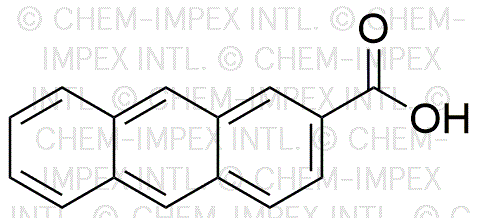2-Anthracenecarboxylic acid is widely utilized in research focused on:
- Organic Synthesis: This compound serves as a key building block in the synthesis of various organic materials, including dyes and pharmaceuticals, due to its stable structure and reactivity.
- Fluorescent Probes: Its unique fluorescence properties make it an excellent candidate for developing fluorescent probes used in biological imaging and detection methods.
- Polymer Chemistry: It can be incorporated into polymers to enhance their optical properties, making it valuable in the production of advanced materials for electronics and coatings.
- Research in Material Science: The compound is studied for its potential in creating new materials with specific electronic and optical characteristics, which can lead to innovations in sensors and solar cells.
- Pharmaceutical Applications: Its derivatives are explored for potential therapeutic uses, particularly in cancer research, due to their ability to interact with biological systems effectively.
General Information
Properties
Safety and Regulations
Applications
2-Anthracenecarboxylic acid is widely utilized in research focused on:
- Organic Synthesis: This compound serves as a key building block in the synthesis of various organic materials, including dyes and pharmaceuticals, due to its stable structure and reactivity.
- Fluorescent Probes: Its unique fluorescence properties make it an excellent candidate for developing fluorescent probes used in biological imaging and detection methods.
- Polymer Chemistry: It can be incorporated into polymers to enhance their optical properties, making it valuable in the production of advanced materials for electronics and coatings.
- Research in Material Science: The compound is studied for its potential in creating new materials with specific electronic and optical characteristics, which can lead to innovations in sensors and solar cells.
- Pharmaceutical Applications: Its derivatives are explored for potential therapeutic uses, particularly in cancer research, due to their ability to interact with biological systems effectively.
Documents
Safety Data Sheets (SDS)
The SDS provides comprehensive safety information on handling, storage, and disposal of the product.
Product Specification (PS)
The PS provides a comprehensive breakdown of the product’s properties, including chemical composition, physical state, purity, and storage requirements. It also details acceptable quality ranges and the product's intended applications.
Certificates of Analysis (COA)
Search for Certificates of Analysis (COA) by entering the products Lot Number. Lot and Batch Numbers can be found on a product’s label following the words ‘Lot’ or ‘Batch’.
*Catalog Number
*Lot Number
Certificates Of Origin (COO)
This COO confirms the country where the product was manufactured, and also details the materials and components used in it and whether it is derived from natural, synthetic, or other specific sources. This certificate may be required for customs, trade, and regulatory compliance.
*Catalog Number
*Lot Number
Safety Data Sheets (SDS)
The SDS provides comprehensive safety information on handling, storage, and disposal of the product.
DownloadProduct Specification (PS)
The PS provides a comprehensive breakdown of the product’s properties, including chemical composition, physical state, purity, and storage requirements. It also details acceptable quality ranges and the product's intended applications.
DownloadCertificates of Analysis (COA)
Search for Certificates of Analysis (COA) by entering the products Lot Number. Lot and Batch Numbers can be found on a product’s label following the words ‘Lot’ or ‘Batch’.
*Catalog Number
*Lot Number
Certificates Of Origin (COO)
This COO confirms the country where the product was manufactured, and also details the materials and components used in it and whether it is derived from natural, synthetic, or other specific sources. This certificate may be required for customs, trade, and regulatory compliance.


